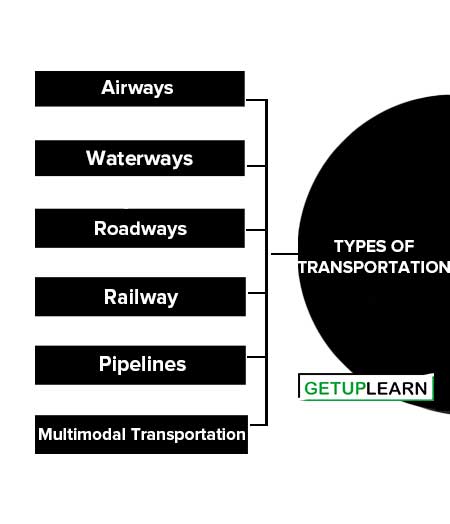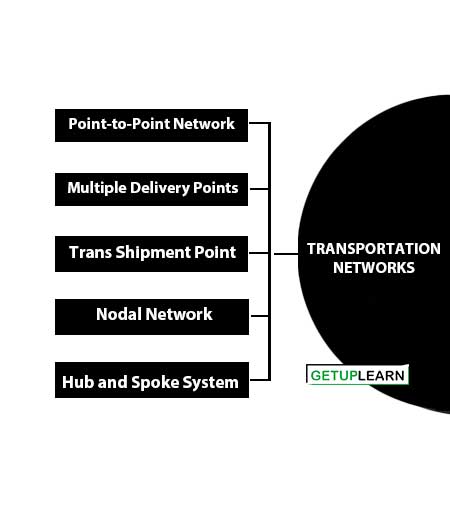Table of Contents
What is Transportation?
Transportation refers to the movement of goods from one location to another. In other words, raw materials can be transported from suppliers to the production facilities and finished goods from there to the consumers.
Transportation plays a significant role in physical distribution processes because products are rarely produced and consumed in the same location. The very mission of physical distribution management is to make available the right quantity of the right quality goods at the right time and place at the least cost.
This can be achieved by proper planning of the movement of goods and appropriate use of transportation resources. Transportation usually represents the greatest distribution cost. It is usually easy to calculate because it can be related directly to weight or number of units.
Costs must be carefully controlled through the mode of transport selected amongst alternatives, and these must be constantly reviewed.
The patterns of retailing that have developed, and the pressure caused by low stock holding and short lead times, have made road transport indispensable. When the volume of goods being transported reaches a certain level some organizations purchase their own vehicles, rather than use the services of haulage contractors.
Types of Transportation
Various modes of transport are used by organizations for specific purpose movement of various types of goods. The basic types of transportation are discussed below:

Airways
Air transportation is the most expensive mode of transportation and is therefore mostly used for goods of high unit value, perishable goods, and emergency shipments to fill important orders that could not be filled out of inventory. This mode of transport is the newest and least preferred mode, especially for domestic purposes.
One of the significant advantages of air transportation lies in the speed. That is why it is the most preferred mode of transport for perishable goods like flowers or for emergency services like the supply of a spare part during the breakdown of a machine. However, the freight of this mode is highest in comparison with other modes.
Waterways
Water transport has been broadly divided into two types. They are inland water transport and water transport. Water transport is very old. It is the cheapest mode of transportation. Rail and road transports require special tracks and surfaces before they can be used. A large amount of money is needed in their operation.
But canals, rivers, and oceans have their natural. So, the Surface they are very cheap. Water transport has considerably developed the internal and external trade of the country. Due to the globalization of the world market, waterways have a large potential for foreign trade.
Throughout the world, this mode has acquired a very high position due to its advantages like being the cheapest, having a larger capacity and flexibility. However, the greatest drawback of it lies in terms of slow speed.
Roadways
Road infrastructure is a large consumer of space with the lowest level of physical constraints among transportation modes. However, physiographical constraints are significant in road construction with substantial additional costs to overcome features such as rivers or rugged terrain.
Road transportation has average operational flexibility as vehicles can serve several purposes but are rarely able to move outside roads. Most of the physical distribution operations of corporate enterprises largely depend on this mode of transport.
Railway
They are the main carriers of goods. They are especially suited for handling heavy bulky items, over long distances at low costs. Grain, coal, wool, stones, sand, etc are transported by railroads at a relatively low cost. When lead time is a less critical element of marketing effort, or when lowering transport costs is a major objective, this mode of transport becomes viable.
Similarly, when goods are hazardous or bulky in relation to value, and produced in large volumes then rail transport is advantageous. Rail transport is also suitable for light goods that require speedy delivery (e.g. letter and parcel post).
Pipelines
This mode of transport is a very significant one but with a very restricted scope. Pipeline is used primarily for the shipment of liquid and gas like crude petroleum, and refined and natural gas. The basic nature of this mode of transport is unique in comparison to all other modes.
It includes a significant initial fixed cost in setting up the pipeline and related infrastructure, the lowest variable cost, 80 to 90 percent optimization of pipeline capacity utilization, 24-hour operation, and not being labor intensive. However, pipelines are not flexible and this scope is limited with respect to commodities.
Multimodal Transportation
As we know, every mode of transport has its own strengths and limitations in absolute as well as relative terms. That is why, after realizing their limited strengths and emerging challenges, various modes of transport have started cooperating with each other to pool their resources and facilities so as to have a win-win situation for all while meeting the service expectations of their customers.
Multi-modal transportation is defined as the carriage of goods by at least two different modes of transport. In multi-modal transport, one transport document, and one rate and through-liability are used. The ultimate aim of multi-models is to make the movement of goods from seller to buyer more efficient through faster transit at reduced costs. Some of the commonly known multi-mode transport options are:
-
Piggyback: Piggyback is the best-known and most widely used inter-modal transportation system, which is an outcome of the coordination between railways and roadways.
-
Fishyback: The inter-modal transportation system is achieved by the coordination of road and water modes of transport. In other words, in fishyback service, the goods containing boxes are loaded on the trailer which will be further loaded on a ship.
-
Trans-Ship: Trans-ship refers to an inter-modal transportation system which is the combination of coordination efforts of railways and waterways for the “bulk movement of freight cargo.
- Airtruck: As the name itself says, this intermodal transportation system is the outcome of the coordination between airways and roadways.
In a nutshell, the chosen transportation mode should adequately protect goods from damage in transit (a factor just mentioned makes air freight popular over longer routes as less packaging is needed than for long sea voyages). Not only do damaged goods erode profits, but frequent claims increase insurance premiums and inconvenience customers, endangering future business.
Selection of Transportation Mode
For the selection of the appropriate transportation mode to move goods from one place to another, it is always necessary to have a comprehensive approach incorporating various factors. A distribution manager is required to take into consideration the following factors while selecting a transportation mode:
- The strengths and weaknesses of the organization in terms of marketing, financial and production resources.
- The prevailing market characteristics include the competitive scenario and geographical and territorial structure.
- Braved equity of the organization’s products in the eyes of customers to bear with a stock-out situation.
-
Product features and suitability to various modes of transportation such as weight, size, shape, etc.
- Quantity to be transported each time.
- Distance to be covered.
- Total transportation cost of various modes of transportation.
- Carrier performance in terms of speed, availability, flexibility, frequency, reliability, safety, versatility, claim settlement procedure, and logistical service capabilities.
Transportation Networks
The movement of goods from the point of production to the point of consumption is done through various modes of transportation.
Depending on transportation load, number of delivery points, existing distribution centers, product value, frequency of delivery, urgency, and cost economies, different types of networks are used, such as:
- Point-to-Point Network
- Multiple Delivery Points
- Trans Shipment Point
- Nodal Network
- Hub and Spoke System

Point-to-Point Network
It is quite common for long-distance hauls on national highways. The point of origin and destination are fixed. Complete truck loading is assured both ways.
Multiple Delivery Points
It is used for round-trip operations with multiple pickup and delivery points. For example, the delivery of filled bottles and the pickup of empty bottles of soft drinks at multiple points on the fixed route is quite common.
Trans Shipment Point
These are two local area networks having a common point where loading and unloading take place for freight consolidation or break bulk.
Most of the national transporters maintain two types of fleets that are vehicles dedicated to national long-distance haulage and other ones for catering to local networks. The consignment from long distance fleet is trans-shipped to local vehicles for distribution across the local area.
Nodal Network
These networks are used for multi-modal transportation systems and include multi-stops and trans-shipment pickups and delivery stations.
For example, a box container truck may have predetermined multi-point pickup stations for freight consolidation on its way to the rail terminal from where the box container may be taken to the port terminal for loading on the ships.
Hub and Spoke System
This arrangement is like a hub and spoke of the wheel. The hub acts like a central feeder point to the distribution centers, which are the strategic locations spread across the geographical area.
The high volume and high-speed shipment take place from the hub to distribution centers through the predetermined short routes called spokes. The trans-shipment of the consignment is done at distribution centers for distribution across the local area.
FAQs About the Transportation
What are the types of transportation?
Transportation refers to the movement of goods from one location to another. The types of transportation are Airways, Waterways, Roadways, Railways, Pipelines, and Multimodal Transportation.
